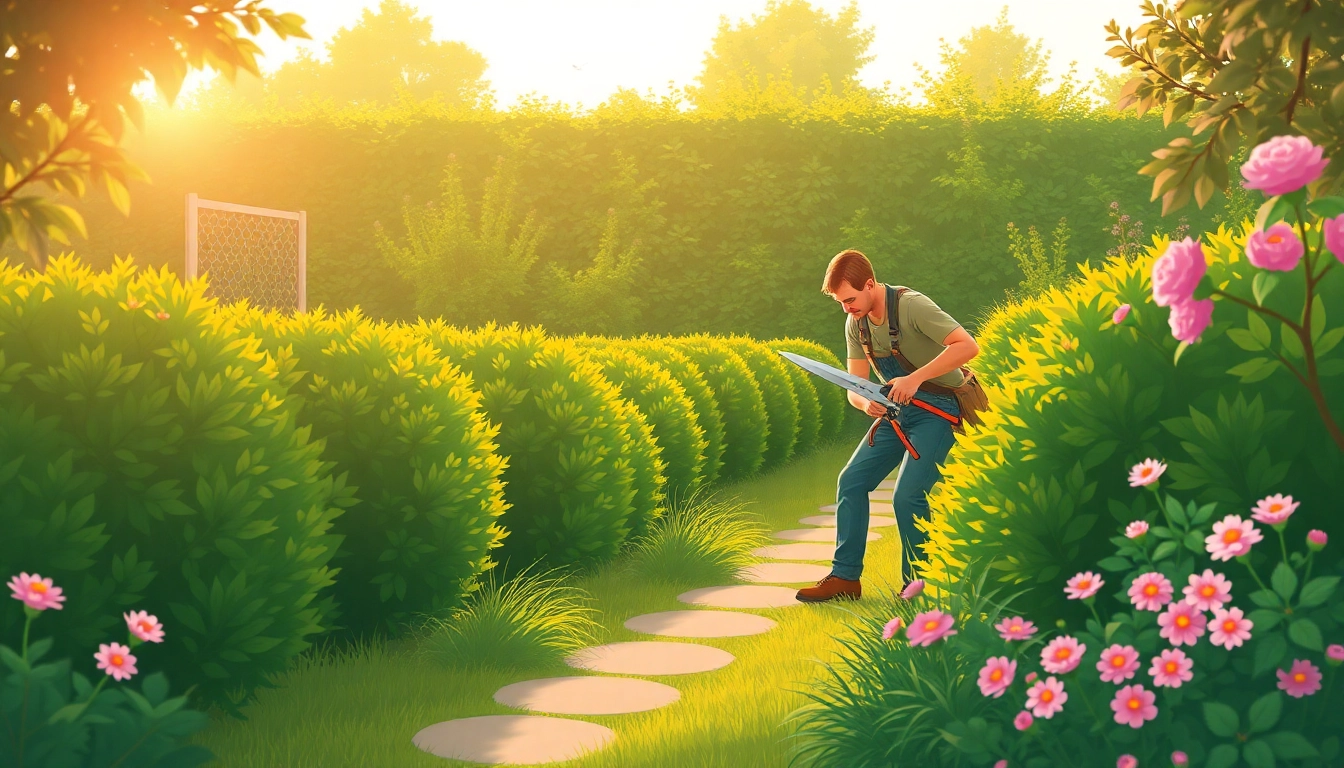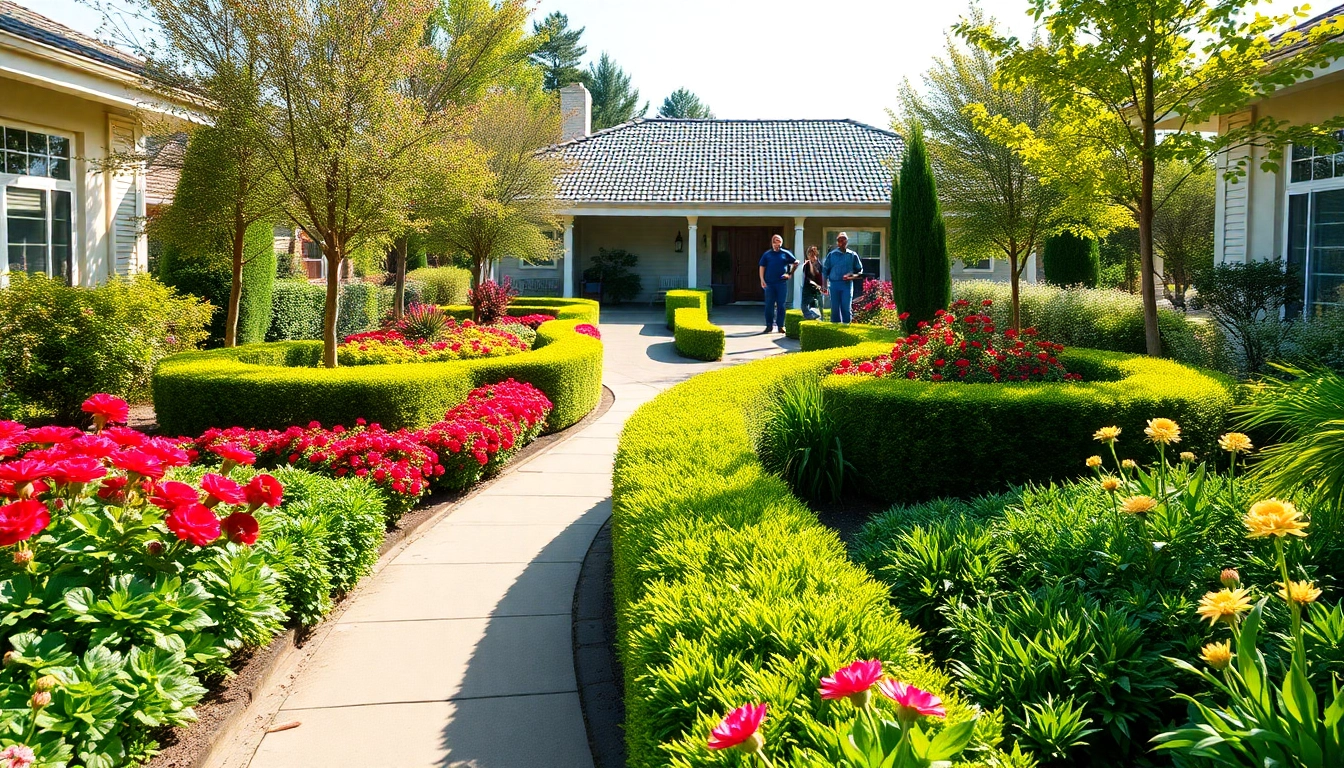Understanding Shrub Trimming Basics
What is Shrub Trimming?
Shrub trimming, commonly referred to as pruning or shaping, is a horticultural practice that involves the selective removal of certain parts of a shrub—typically its stems, branches, and leaves. This technique promotes healthy growth, enhances the aesthetic appeal of the shrub, and ultimately increases the longevity of the plant. Unlike general landscape maintenance, which may involve mowing and leaf collection, shrub trimming focuses on cultivating the specific forms and functions of the plants in your garden. Trimming stimulates new growth from the shrub, allowing it to flourish rather than become overgrown and unkempt. For more detailed guidance on shrub trimming techniques, including best practices and common mistakes to avoid, you can consult resources such as shrub trimming websites.
Benefits of Proper Shrub Trimming
Proper shrub trimming not only enhances the visual aesthetics of landscaping but also promotes the health and growth of shrubbery. Here are several key benefits:
- Encourages Fuller Growth: Regular trimming stimulates growth by encouraging the formation of new shoots and flowers, leading to a denser, bushier plant.
- Healthier Plants: Trimming removes dead or diseased branches, which can be a breeding ground for pests and disease.
- Aesthetic Value: Well-trimmed shrubs enhance the overall appearance of your garden, providing a clean and organized look.
- Enhances Flower Production: Many flowering shrubs benefit from proper trimming, leading to increased blooms and a more vibrant display.
- Promotes Safety: Trimming can help prevent branches from obstructing walkways or vehicle paths, thereby enhancing safety.
Common Shrub Types and Their Needs
Identifying the types of shrubs in your landscape is crucial for successful trimming, as different species have unique growth habits and trimming requirements. Here are a few common types:
- Deciduous Shrubs: These shrubs lose their leaves in fall. Pruning is best done in late winter or early spring before new growth begins.
- Evergreen Shrubs: Retaining their leaves throughout the year, evergreens benefit from light trimming during the growing season.
- Flowering Shrubs: Timing of trimming varies by species. Spring-blooming shrubs should be trimmed immediately after flowering, while summer-blooming varieties can be trimmed in early spring.
- Fruit-bearing Shrubs: Trimming these shrubs post-harvest can enhance next year’s yield and maintain size.
Best Practices for Effective Shrub Trimming
Tools and Equipment for Shrub Trimming
Having the right tools is essential for effective shrub trimming. Here are some must-have tools for any homeowner or landscaping professional:
- Pruning Shears: Ideal for small branches and fine detail work.
- Loppers: These long-handled tools are perfect for thicker branches that hand shears struggle with.
- Hedge Trimmers: Electric or manual hedge trimmers are great for maintaining the shape of larger hedges and shrubs.
- Hand Saw: For exceptionally thick branches, using a hand saw can help when other tools fall short.
- Protective Gear: Safety goggles, gloves, and long sleeves are recommended to protect against sharp tools and irritating plant materials.
Techniques to Enhance Aesthetic and Health
Employing the right techniques during shrub trimming maximizes both aesthetics and the health of the plants. Here are several effective techniques:
- Thinning: This involves removing inner branches to allow more light and air circulation, promoting healthy growth.
- Shearing: This technique is ideal for creating geometric shapes and is often used for formal hedging.
- Rejuvenation Pruning: This is needed for overgrown shrubs; cutting back to the base promotes new growth.
- Cutting at an Angle: Always make cuts at a 45-degree angle to prevent water accumulation, which can lead to rot.
- Following Growth Patterns: Pay attention to how the shrub naturally grows and prune according to its natural shape.
Seasonal Considerations for Shrub Trimming
Understanding the best seasons for shrub trimming is essential to support healthy growth and flowering. Key considerations include:
- Spring: Trim spring-flowering shrubs after blooming; this allows them to develop flowers for the following year.
- Summer: Summer-flowering varieties can be trimmed in early spring to encourage robust blooming.
- Fall: Avoid late fall trimming, as this can expose shrubs to winter damage.
- Winter: Dormant season is great for trimming deciduous shrubs, as these can be shaped without influencing their growth cycle.
Timing Your Shrub Trimming
When to Trim Different Shrub Varieties
Timing your shrub trimming can significantly impact the plant’s health and blooming performance. Here’s a breakdown for popular shrub types:
- Forsythia: Trim immediately after flowering to avoid removing buds for the next season.
- Hydrangeas: Depending on the variety, some are best trimmed in late winter, while others should only be pruned post-flowering.
- Lavender: Trim in late summer after blooming for healthier foliage and to encourage re-blooming.
- Roses: These typically require spring trimming to remove dead wood and promote new blooms.
- Boxwood: Given their popularity in formal landscaping, boxwoods can be lightly trimmed in late summer and heavily trimmed in early spring.
Indicators That Your Shrubs Need Trimming
There are several signs that indicate a shrub is due for trimming:
- Excessive overgrowth that obstructs pathways or views.
- Dead or yellowing branches in need of removal to tidy up the plant.
- Unattractive shapes that detract from landscaping design.
- Pest Infestation: Visible pests may require trimming away affected areas to manage the problem.
- Reduced flowering or fruit production can signify a need for rejuvenation pruning.
Managing Timing Based on Local Climate
When planning your shrub trimming schedule, consider the specific climate of your area, as this can influence growth patterns. In warmer regions, trimming may need to occur sooner in the spring, whereas in cooler climates, late winter trimming may be more appropriate. Be mindful of local frost dates, and ensure that you avoid trimming just before a predicted frost, which can stress the plants.
Avoiding Common Shrub Trimming Mistakes
Over-Trimming and Its Consequences
One of the most common mistakes in shrub trimming is over-trimming, which can leave the shrub vulnerable to stress and disease. Symptoms of over-trimming may include:
- Weak or stunted growth.
- Increased susceptibility to pests and disease due to diminished foliage.
- Unattractive shapes that detract from the overall landscape design.
Adhering to the “one-third rule”—where you only trim a maximum of one-third of the shrub’s total mass at any time—can help prevent these issues.
Ignoring Shrub Growth Patterns
Each shrub has a unique growth pattern that should influence how and when it’s trimmed. Ignoring these patterns can lead to severe consequences:
- Trimming against the natural growth direction can lead to sparse foliage and stunted growth.
- Failure to recognize dormant periods can stress the shrub and inhibit new growth.
- Improper timing can result in cutting off buds that are meant to become flowers.
Incorrect Use of Tools
Using the wrong tool for the job can lead not only to poor results but can also damage the plant. Here are some tips to avoid tool-related mistakes:
- Always use sharp shears and saws; dull tools can crush branches instead of cutting cleanly.
- Choose the right size tool for the branches; for example, use loppers for branches larger than what pruning shears can handle.
- Inspect your tools regularly for wear and tear; investing in quality tools pays off in the long run.
Professional vs. DIY Shrub Trimming
Indicators That You Need a Professional
While many homeowners can effectively trim their shrubs, there are scenarios when hiring a professional is beneficial, such as:
- If the shrubs are extensive and beyond manageable sizes.
- When specialized techniques, like rejuvenation pruning or intricate topiary work, are required.
- To handle extensive pest or disease infestations that will require more than simple trimming.
- If you lack time or expertise, hiring a professional can save both time and future trouble.
Cost Considerations for Hiring Help
Understanding the cost of hiring a professional for shrub trimming can navigate your decision. Typically, homeowners can expect to pay approximately:
- Per Hour: Depending on the region, costs can range from $48 to $75.
- Per Bush: This can range from $6 to $16 per bush, depending on the size and complexity of the job.
- Additional Fees: Consider potential extra costs for travel, large jobs, and large equipment required.
How to Choose the Right Shrub Trimming Service
Choosing a professional trimming service can be daunting. Here are some helpful tips:
- Research Reviews: Check online reviews and ask for recommendations from others.
- Obtain Multiple Quotes: Comparing several services can give a sense of fair pricing.
- Verify Licensing and Insurance: Ensure that the service provider has proper credentials and insurance for liability.
- Ask Questions: Inquire about their techniques and approach to shrub care to ensure alignment with your expectations.



